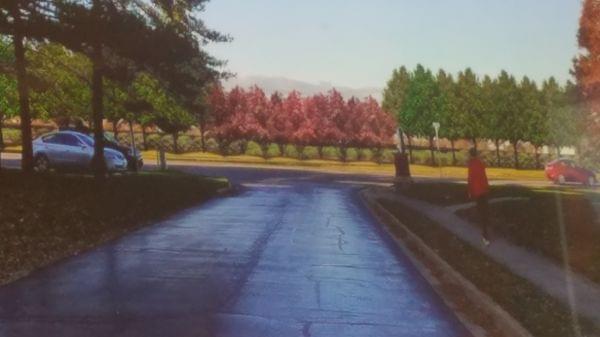Savoy Village Board Learns Details Of New Solar Farm Plans

U of I officials showed this concept drawing to the Savoy Village Board Tuesday night, depicting the vegetation buffer that Curtis Road residents would see in front of a planned 50-acre solar farm. Jim Meadows/Illinois Public Media
The University of Illinois does not need permission from Savoy village officials to build their new solar panel farm on Curtis Road, just outside village limits. But at a Savoy Village Board study session Wednesday night, university officials promised that the 50-acre facility would be a good neighbor.
Mohamed Attalla, the head of the U of I’s Facilities and Services unit, told Savoy village trustees that the university will take steps to make sure that noise from the solar farm’s inverters and other electrical equipment won’t be heard by anyone in the three apartment complexes located across Curtis Road from where the facility will be built.
“So we make sure the inverters are installed at a far-back distance within the project,” said Attalla. “We’ll have sound attenuation around the condensers, which are the source of the noise. Plus, we’ll have the buffer of trees as well.”
Attalla referred to trees and other vegetation that the university will plan in front of the new solar farm. They’re meant to muffle any noise and provide a pleasing view for those living across the street from the solar panels.
Trustee Jan Niccum remained skeptical about the new solar farm, including the university’s plan for a vegetation buffer.
“In their diagrams, they showed mature trees that were shielding the project,” said Niccum. “And not too many people plant mature trees. And even the mayor mentioned in the wintertime, those trees will be denuded, and there will be no shielding of the project at that time.”
Savoy Mayor (also known as Village President) Joan Dykstra said she believed the university’s new solar farm would be a good neighbor to the apartment residents along Curtis Road.
“They’ve listened to everything that we have asked,” said Dykstra. “They’ve answered all of our questions, and I’m really pleased with the answers that we’ve gotten. And I’m pretty confident that this is a project that the people on Curtis Road will be proud of and they will think it’s a project that will not impact them negatively at all.”
Trustee Niccum also acknowledged that the university had responded to Savoy officials. Some of his doubts went beyond issues of noise and aesthetics, and centered around the project’s long-term viability. The trustee asked questions about how the solar panels would be disposed of, or recycled, when they were decommissioned, and whether the price of electricity from the solar farm would be competitive with other electrical sources.
Attalla said he believes that the price the university pays for electricity from the new solar farm will be competitive with prices for electricity from conventional sources. That is not the case with the U of I’s existing solar farm on Windsor Road. Attalla says improvements in technology have brought down the price of solar-generated electricity since the university’s first solar farm opened in 2015.
Construction of the new solar farm on Curtis Road is expected to start in 2019, and begin producing electricity for the University of Illinois Urbana campus some time in 2020. A contractor will build and operate the solar farm, and sell the eletricity to the university, which reserves the right to buy back the solar farm after a certain number of years. The new solar facility is expected to produce 18 gigawatts of power per year, compared to the seven gigawatts produced by the smaller, existing solar farm on Windsor Road.
